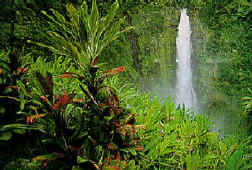


Measuring from its submarine base (3,280 fathoms) in the Hawaiian Trough to the top of the mountain (13,796 feet), Mauna Kea is the tallest mountain in the world with a combined height of 33,476 feet. Geographic coordinates of Honolulu, the state capital, is 2118 25 North Latitude, 157 51 30 West Longitude. The July 1, 1991 resident population for the State of Hawaii was 1,134,800 persons. (Between the 1980 and 1990 Census counts --964,691 and 1,108,229 persons -- Hawaii's population grew 14.9 percent).
State of Hawaii Emblems and Insignia
The State Seal has a heraldic shield in the center and a figure of King Kamehameha I on its right side and the Goddess of Liberty holding the Hawaiian flag on its left. Below the shield is the Phoenix surrounded by taro leaves, banana foliage, and sprays of maidenhair fern. Statehood was achieved in 1959. With color added, the seal becomes the State Coat of Arms.
The State Flower is the yellow Hibiscus Brackenridgei. The official flowers and colors for each island is as follows:
Hawai'i, Red Lehua (Ohia), color Red
Maui, Lokelani (Pink Cottage Rose), color Pink
Moloka'i, White Kukui Blossom, color Green
Kaho'olawe, Hinahina (Beach Heliotrope), color Gray
Lana'i, Kaunaoa (Yellow and Orange Air Plant), color Yellow
Oahu, Ilima, color Yellow
Kaua'i, Mokihana (Green Berry), color Purple
Ni'ihau, White Pupu Shell, color White
Hawai'i's State Tree is the indigenous kukui, better known as the candlenut.
The nuts of this tree provided the ancient Hawaiians with light. oil. relishes.
and medicine.
The State Bird: The Nene (pronounced "nay-nay") is a land bird
and a variety of goose. It has adapted itself to life in the harsh lava country
by transforming its webbed feet into a claw-like shape and modifying its wing
structure for shorter flights. Hunting and wild animals all but destroyed the
species until they were protected by law and a restoration project established
in 1949.
Marine Mammal: The Humpback Whale, an annual visitor to Hawaiian waters
and so designated in 1979.
State Fish: The Humuhumunukunukuapua' a (pronounced "humuhumunukunukuapua'
a").
Flag: The State Flag has eight stripes (representing the eight major
islands), of white, red and blue; the field closely resembles the Union Jack
of Great Britain, from which the original flag apparently was designed.
Motto: The words Ua mau ke ea o ka aina i ka pono which mean "The
life of the land is prepetuated in righteousness." The saying is attributed
to King Kamehameha III as of July 31, 1843, when the Hawaiian flag once more
was raised after a brief period of unauthorized ursurpation of authority by
a British admiral.
Anthem: Hawai'i Pono'i, written by King Kalakaua and set to music by
Henry Berger, the Royal Bandmaster. It was also the anthem of the Kingdom and
the Territory of Hawaii.

The State of Hawai'i is comprised of eight major islands:
O'ahu (Population 836,207) The most populated island,
where Honolulu is the Capital City, the principal port, the major airport, and
business and financial center, and the educational heart of the State. O'ahu
is the military command center of the Pacific. Waikiki is the visitor center.
Landmarks: Nuuanu Pali, Diamond Head, Pearl Harbor.
Kaua'i (Population 50,947) The "Garden Island" offers magnificent
scenery and lush vegetation, beautiful waterfalls, the spectacular Waimea Canyon,
the great "hidden" valley of Kalalau, colorful tropical plants and
flowers. Landmarks: Hanalei Bay, Wailua River, Nawiliwili Bay, Poipu Beach.
Ni'ihau (Population 230) Privately owned island, with livestock raising
as its principal industry; highly limited access by general public through helicopter
landings at uninhabited sites. Legend says it was the original home of the goddess
Pele.
Moloka'i (Population 6,717) The "Friendly Isle" has diversified
agriculture, ranching, tourism and the world's highest sea cliffs along its
northern coast. On a 13-square-mile peninsula below high cliffs is Kalaupapa,
the Hansen's Disease settlement, officially called Kalawao County, a National
Historical Park.
Lana'i (Population 2,426) Contains 140 square miles. Almost the entire
island was a Dole Company pineapple plantation but is now phasing in tourism.
Kaho'olawe Uninhabited. Once used as a target by U.S. Navy and Air Force
which are cleaning up unexploded shells. No one is allowed to go ashore without
permission.
Hawai'i (Population 120,317) The "Big Island" has spectacular
contrasts...the mighty volcanoes Mauna Loa (13,679 feet) and Kilauea, lofty
snow clad Mauna Kea (13,796 feet), the Desert, gorgeous waterfalls, the Puna
Fern Forest, the colorful orchids of Hilo. The island grows sugar, coffee, cattle
and macadamia nuts. Landmarks: Hawaii Volcanoes National Park, Kealakekua Bay,
Kailua-Kona, Kawaihae, Parker Ranch, Waipio Valley.
Maui (Population 91,361) The "Valley Isle" produces sugar,
pineapple, cattle, horses. The 10,023-foot Haleakala is the largest dormant
volcano crater in the world. Lahaina was Hawaii's capital before 1845, and still
has some of the atmosphere of an old whaling town. Nearby are the Kaanapali
and Wailea resort areas and golf courses. Hana and lao Valley draw many visitors.